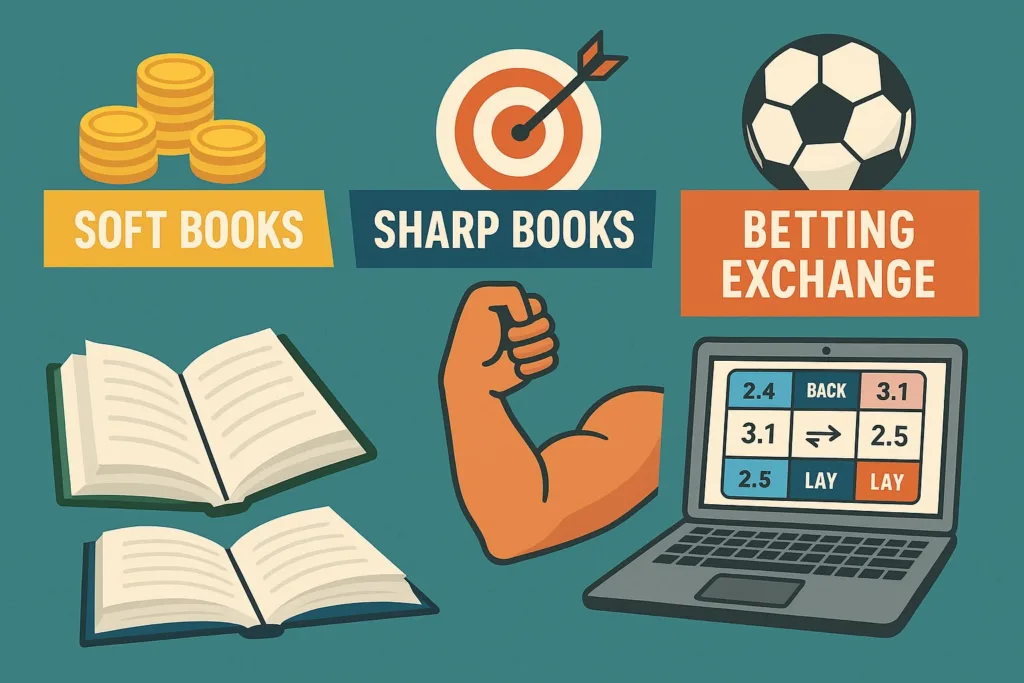
Soft books, sharp books & exchanges
Here is a clear, no-nonsense guide to the differences between soft and sharp bookmakers, and why exchanges are where scalable, long-term profits actually reside.
What do we mean by “soft” and “sharp” books?
- Soft bookmakers (most high-street and mainstream apps) focus on recreation and acquisition. They use higher margins, heavy marketing and aggressive risk controls. They do not want skilled winners.
- Sharp bookmakers (think the market-making model) run tighter margins, welcome volume, and use price as risk control. They tolerate winners because winners help sharpen the line.
- Betting exchanges are peer-to-peer. You bet against other customers, not the house. Winners aren’t limited; your stakes are constrained only by liquidity and your own risk.
How soft books set prices and manage risk
Soft books price with a mix of models, third-party feeds and manual overrides, then protect themselves with:
- Higher overrounds across markets, in simple terms, worse odds.
- Offer design (boosts, bet builders, accas) that raise margins.
- Risk flags (arbing, closing-line beaters, unusual bet timing, correlated selections).
- Rapid stake limits / “gubbing” and, if needed, account closures.
Result: odds can be slow or wrong in places, but the house always controls the risk by whatever means they can—like your maximum stake.
Why it’s possible to beat a soft book (but not for long)
You can win at soft books by:
- Arbitrage/middling: picking off cross-book price gaps.
- Value betting: consistently beating the closing line.
- Offer exploitation: promos, boosts and mispriced props.
But it’s not scalable because:
- Limits arrive quickly. Once your pattern is clear, stakes are slashed to pennies.
- Promos dry up and “palpable error” clauses can void the best hits.
- Operational friction (ID re-checks, withdrawal delays, market restrictions) kills velocity.
Bottom line: beating soft books is often easy but short-lived.
Soft books see attractive offers and odds as a chance to pull in sucker money. They don’t want your business if you’re skilled or do anything clever.
What makes a bookmaker “sharp”?
Sharp books operate on a low-margin, high-volume model. Their risk control is the price itself:
- Efficient lines: faster moves, narrower spreads.
- Winners are information. Your bets help them set better prices.
- Higher limits than soft books, especially near kick-off.
They’re harder to beat precisely because they’re closer to the true price. If you can beat a sharp book, you probably have a real edge.
Where betting exchanges fit (and why pros prefer them)
Exchanges remove the house as counterparty:
- No winner limits. You won’t be stake-limited for being good.
- Make or take price. Post offers (lay or back) and get matched; become a market maker, not just a taker.
- Scalable in principle. Your limit is liquidity, not the book’s tolerance.
- Transparent costs. Commission on net winnings (and, on some venues, additional charges at high profit levels) is explicit and model-able.
Trade-offs:
- You must generate edge or provide liquidity intelligently.
- Execution matters: timing, queue position, fill rates, and market selection.
- Discipline matters even more: bankroll management, variance control, and consistent process.
Soft vs sharp vs exchange: quick comparison
| Feature | Soft Book | Sharp Book | Exchange |
|---|---|---|---|
| Business model | Entertainment, high margin | Market-making, low margin | Peer-to-peer marketplace |
| Attitude to winners | Limits fast | Tolerated | No winner limits |
| Scalability | Poor (stake-capped) | Better (limit-led) | Best (liquidity-led) |
| Typical edge source | Pricing errors, promos | True modelling edge | True modelling edge, microstructure edge |
| Costs | Hidden in price | Lower margin in price | Commission, possible extra fees at high profits |
| Counterparty | The book | The book | Other bettors |
Scale and sustainability: the real constraint
- Soft books: The constraint is the bookmaker. They shut the tap.
- Sharp books: The constraint is your edge against efficient prices and posted limits.
- Exchanges: The constraint is liquidity and your execution. If you have edge, you can scale as deep as the market will fill—in theory unlimited, in practice bounded by market size and your risk tolerance.
The short version
- Yes, you can beat soft books—but they’ll limit you quickly. It’s not scalable and they don’t want sustained skilled action.
- Sharp books are harder to beat because their prices are efficient, but if you can beat them you likely have a robust edge.
- Exchanges are where scalable winning lives. You can, in theory, win unlimited amounts because there are no winner limits—but you’ll only do it with a real, repeatable edge and solid execution, not with one-off pricing errors.
If your goal is to build a durable, scalable betting business, exchanges are the natural home. Bring a model, respect the microstructure, manage risk—and let liquidity, not a bookmaker, decide your ceiling.
